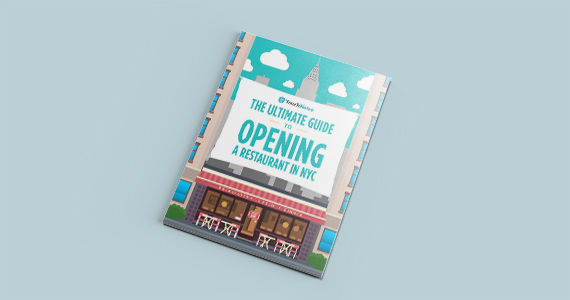Restaurant food consumption is on the rise in New York City, meaning your venue has more opportunity than ever before to appeal to potential customers. The average New Yorker eats out more than five times per week — can you say cha ching!?
With thousands of restaurants to choose from, it can be difficult to reach your intended customers in such a heavily saturated marketplace. Before you start planning your retirement as a multi-millionaire Danny Meyer 2.0, arm yourself with the tools you’ll need to make a lasting impression on the New York restaurant market.

Everything you need to know about setting up a new venue in the Big Apple.
Know Your Customer
There are more than 24,000 restaurants in New York City, but not all of them appeal to every customer. As a business owner and culinary visionary, it’s your job to know who you’re catering to.
For example, if your restaurant is a high-end steakhouse near Wall Street, your target customers are most likely going to be business people who dine during lunch and dinner meetings. Your hours of operation, decor, price point, ambiance, and service must appeal to this demographic of people. If your music is too loud, for instance, business-minded customers will take their lunch meetings elsewhere.
Many restaurant owners don’t take the time to properly understand their customers so they can customize their dining experience. Here are some questions that will help you shape your target market:
- Who are my current customers?
- Are my current customers the people I’d like to continue doing business with?
- Which restaurants are my direct competition?
- What do customers gain when they choose my venue over other restaurants offering a similar experience?
Once you answer these questions, you’ll be able to identify your target market, competition, and your market differentiator.
Carve Out Your Niche
Seventy percent of restaurants in New York City close within three years of opening. One of the biggest contributors to high restaurant failure rates is lack of a market differentiator.
If you want your restaurant to be successful, you have to offer customers something beyond your menu. It may be your dream to open an inexpensive, pizza-by-the-slice shop, but if there are already a plethora of other similar restaurants within close proximity offering the same thing, how will you stand out from the crowd?
Here are some questions to answer when carving out your niche:
- What do I want my business to stand for?
- What does my restaurant do well?
- What does my restaurant focus on?
- Why would customers choose my restaurant over similar restaurants?
- What can I do to gain a larger share of my niche market?
When you answer these questions, you’ll begin to zero in on your market differentiator so you can strengthen it and do it better than everyone else.
Make a Splash
Now that you know what differentiates you from your competition, do something creative to get noticed.
Pietro Nolita is situated within a sea of brick and concrete. The entire venue, however, is painted bright pink, on the inside and outside . A large “Pietro Nolita” neon sign hangs outside of the venue above the stairs, and passersby can’t walk down the block without noticing the restaurant.
Now, don’t panic. There’s no need to run to your nearest Home Depot in search of the brightest gallon of paint you can find. There are other, more subtle ways to make a splash in the market:
- Host special events such as holiday parties and menu tastings at your restaurant.
- Get involved with the local community: participate in food fairs and donate to charities.
- Offer cooking classes, mixology classes, or paint nights at your restaurant.
- Decorate in a memorable and unforgettable way.
When your restaurant stands out (for all the right reasons) prospective customers will notice, and you’ll see an increase in your traffic and sales.
Create a Memorable Slogan
A quick and easy way to ensure your restaurant stands out against its competition is to create a memorable slogan. Your slogan will offer target customers a quick pitch about your brand and restaurant.
Here are some tips to consider when creating your restaurant’s slogan:
- Keep it short and simple. It should roll off of the tongue quickly and be easy to remember. Chipotle’s slogan, “Food with Integrity,” is short, to the point, and directed at its target audience: conscious consumers.
- Be consistent. Your slogan should seamlessly tie in with your restaurant’s logo, concept, and brand. For example, Shake Shack’s slogan, “Stand For Something Good,” shows customers that all of its food is sourced from local producers who don’t use additives and all of its employees are paid higher-than-average wages.
- Make it timeless. Your slogan shouldn’t expire frequently due to pending changes in technology, food trends, etc.
- Focus on what makes your restaurant unique. For example, if your venue is a casual, live music, dinner spot, a slogan such as “Live Music with Every Meal” would capture the essence of your brand and its unique selling point.
By creating a memorable slogan, your restaurant and brand will always be top of mind when your target market is dining out.
Market to Your Niche
At this point you know your target customers and what makes your venue unique. Now you can use your market differentiator as a selling point when advertising to your intended niches.
But first you have to figure out how to reach your target audience. To do this you’ll need to imagine life from their perspective.
You can start by asking yourself these questions:
- Where are they likely to hang out?
- How do they spend their time?
- Are they active on social media? If so, on which channels?
- How can you appeal to their emotions?
For example, if your target customers are social media savvy people who enjoy posting everything they eat for likes and shares, you’ll need to create an Instagram account and post daily. Posting beautiful, mouthwatering photos of your menu items with trending hashtags will enable you to quickly and instantly reach your customer base.
Or maybe your target customers are vegans who advocate against animal cruelty and harmful food additives. For these consumers you’ll need to make sure your brand message is in alignment with their attitudes and beliefs. For example, a simple blurb on your website and restaurant menus such as, “We believe in the ethical treatment of animals and our planet and do not feature any animal products or harmful additives in our dishes,” would speak to this audience appropriately.
Keep in mind: you’ll be most effective when you appeal to your target customers’ emotions. Make them feel like you’re one of them rather than just a business trying to gain access to their wallets.
When you go through these five steps to differentiate your brand, you’ll be able to create a memorable niche in the New York City restaurant market and increase your chances of long-term long-term success.
[sc name=”How to Manage and Reduce Restaurant Food Waste in NYC CTA”]
Free job application template for restaurants
Sign up for our free weekly TouchBistro Newsletter







